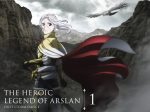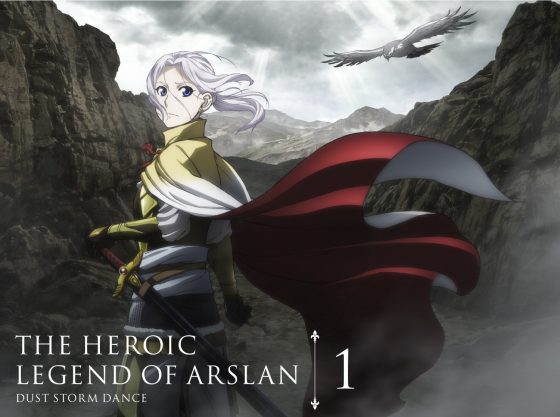

Based on the novel series by Yoshiki Tanaka, Arslan Senki is a coming-of-age tale of Arslan, Prince to the Kingdom of Pars, as he learns to become a leader after the capture of his father. Under the tutelage of Daryun and Narsus, two elite warriors, Arslan gets on-the-job training in becoming a king as he faces the opposing kingdom of Lusitania. Though a recent anime based on the manga by Hiromu Arakawa (the creator of Fullmetal Alchemist) was broadcasted in 2015, did you know there was an OVA series released as far back as 1991? If not, then for this edition to Then Vs. Now, we’d like to explore these two different versions of Arslan Senki.
Story
When counting both seasons of the 2015 series, it’s obvious that the the newer version is going to cover more ground since more novels were also published by then (the novel series didn’t end until December 2017 with the first novel debuting in August 1986!). Other than that, the premises of the stories are pretty much the same, but with some slightly different executions. For example, bits and pieces of Arakawa’s humor that you would see in Fullmetal Alchemist, Silver Spoon, or Jushin Enbu are inserted into this series, most emphatically on Narsus’ supposed (and allegedly awful) attempts at art. This is seen with the facial expressions of Daryun and Arslan when they see his paintings. A bit of Arakawa’s humor is also injected with Gieve as he wants to introduce himself to Farangis. Other than that, both contain a highly serious and intense tone. One notable difference however is how Etoile/Ester is introduced and used. When she is introduced in the beginning of the 2015 anime series, she is disguised as a boy and is trying to fight for her beliefs that everyone should be equal. Around this time, she kidnaps Arslan (without knowing he’s actually the prince!) and shares her beliefs with him, thus opening his eyes that there’s a world beyond what he was raised in, and it largely contributes as to why he wants to end slavery. As it turns out, she’s a soldier from Lusitania and they would meet again 3 years later on the battlefield. Their relationship is loosely explored in bits and pieces of the 2015 series to the point it’s teased they could be in love. In the 1991 version, she isn’t introduced until the latter half and their previous encounter three years prior to the story beginning isn’t even mentioned or shown. Her role in the 1991 series is rather small but elements of the initial tension she has with Arslan are still present. If anything, she’s just a fan service cameo to fans of the novel series.
Design
In case you didn’t know, Yoshitaka Amano, who is best known for working as a character designer for the Final Fantasy series, does the cover art for some of the novels. Though he didn’t work on the 1991 anime, a lot of the designs in that respective series do take influence from it. As for the 2015 version, if you’ve seen Fullmetal Alchemist or anything based on Hiromu Arakawa, you’ll instantly recognize her style and you could connect one character from this anime to Fullmetal Alchemist. For example, Arslan shares a lot of resemblances to Ed with their faces, height, and hairstyles. Other than that, both designs share numerous common qualities between the description of the characters and their clothing. Arslan in both versions have pale skin, long white hair, and tends to wear white. His design in all versions does its job by making those around him mis-assume that he’s weak due to how frail he looks, but he‘s much stronger and wiser than he looks. Daryun in the 2015 version has longer hair than his 1991 counterpart and tends to tie it in a ponytail, but the core qualities are still there. For Alfreed, the daughter of the bandits, their designs slightly differ. Though they both share red hair and cover it with a blue bandana, the 2015 Alfreed keeps most of her hair in her bandana while the 1991 version wears it down. Also, the 2015 version wears warmer clothing to reflect her nomadic and outdoor lifestyle, while the 1991 version wears clothes that look like pajamas. Lastly, the 2015 version wears warpaint on her cheeks when the 1991 version doesn’t. Gieve in the 1991 series has more of a feminine design to him but obviously looks male in the 2015 series. As for Farangis, she wears a skimpy sheet just covering his private parts in the 2015 version, but she’s a lot more clothed in the 1991 series in a manner more appropriate for the battlefield. Last, Hilmes’ mask in both versions are largely different but serve the same purpose, to hide the scars he got in a fire from his childhood no thanks to Arslan’s father. In the 1991 series, the mask is pretty much a night’s helmet that entirely covers his head, while the 2015 version just exclusively covers the upper-half of his face, thus exposing his mouth and hair.
Final Thoughts

If you watch some of the clips back-to-back or side-by-side, a lot of the dialog matches exactly word for word so you’re getting two series that ultimately respect the original novel series. With the novel series finally complete, let’s hope in the near future that we can get a continuation of the anime based on the Arakawa manga that gives us the full story. The ending to the novel series is rather weird (which we won’t spoil), but we would like to see how it plays out differently as an anime and hopefully, we can have that opportunity since audiences enjoyed seeing these characters grow both individually and how their relationships develop.
[recommendedPost post_id='67851' url='' title='' img='' class='' widget_title=''] [recommendedPost post_id='17279' url='' title='' img='' class='' widget_title=''] [recommendedPost post_id='174170' url='' title='' img='' class='' widget_title=''] [recommendedPost post_id='20809' url='' title='' img='' class='' widget_title='']
Add Comments